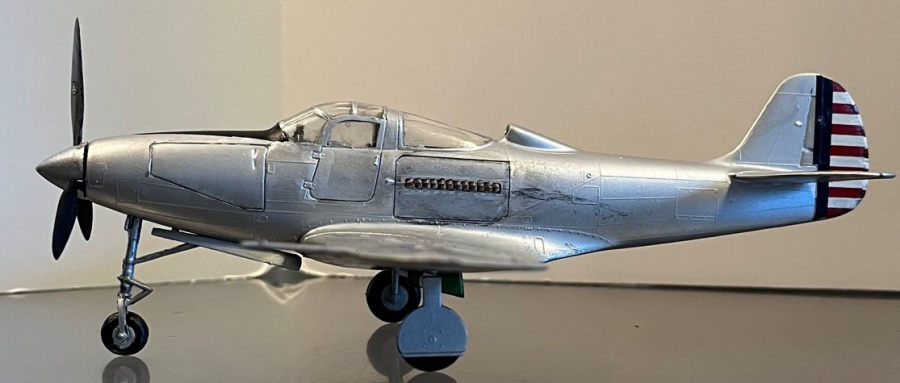
| KIT #: | 6844 |
| PRICE: | $ |
| DECALS: | One option |
| REVIEWER: | David Cummings |
| NOTES: | 1983 boxing |

| HISTORY |
History Ė So we all know the story of the airplane designed with the engine placed behind the pilot to make room in the nose for a big cannon. And a bad decision made to drop the proposed turbo-supercharger. Not having a supercharger would make the aircraft a poor performer. And the mid-engine made it a death trap in a spin. While there is an element of truth to some of that, the Airacobra story is much more complex.
Bell Aircraft responded to a 1937 Air Corps request for a single-engine high-altitude "interceptor." Despite being called an interceptor, the proposed aircraft's role was simply a refinement of the traditional pursuit (fighter) role to intercept aircraft at higher altitudes. Specifications called for a heavy armament including a cannon, a liquid-cooled Allison engine with a General Electric turbo-supercharger, tricycle landing gear, a level airspeed of at least 360 mph (580 km/h) at altitude, and a climb to 20,000 ft (6,100 m) within 6 minutes. This was the most demanding set of fighter specifications USAAC had presented to that date. It also came at just the wrong time. The P-39 just missed the advances in technology that would benefit the later types that would replace it. Turbo-supercharging was still cutting edge and presented many problems for a single engine fighter with size and weight being the most prominent.
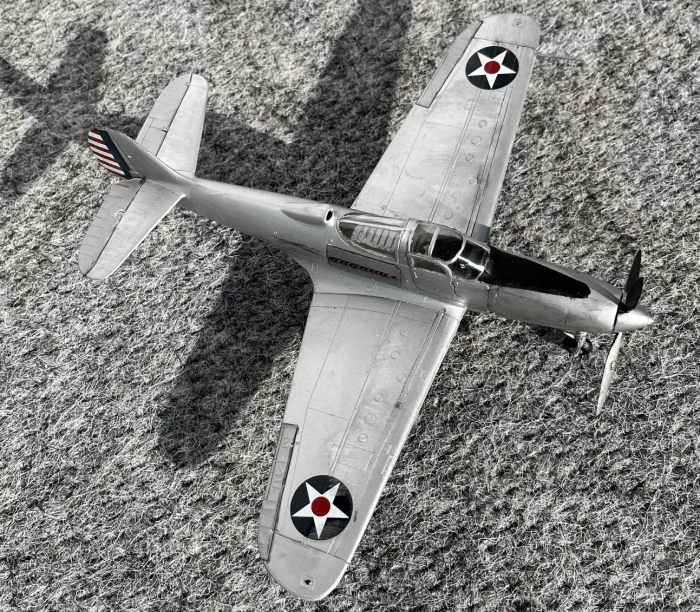 Much is made
of Bellís idea to place the engine behind the pilot to accommodate a 37mm
cannon. However, Bellís Chief Designer, Robert Woods, never mentioned this as a
priority of the design. In the March 1940 edition of Aviation Magazine, Woods
writes an article promoting the P-39. He describes the purpose of the mid-engine
design allowed for better aerodynamics by enabling a more streamlined nose
profile. He describes the P-39 nose asĒ being equivalent to the shape of a high
velocity bullet.Ē He also makes much of the center-of-gravity being where most
of the weight is concentrated. This decreases moment inertia which should
increase the aircraftís ability to turn quicker, aiding maneuverability. He then
talks about the advantages of the tri-cycle landing gear. Landing incidents were
the number one cause of USAAC aircraft accidents at the time and landing with a
nose wheel was known to be easier than with a tail dragger. He mentions that the
design makes room for heavy armament, but it doesnít seem to be high on his list
of reasons for the design.
Much is made
of Bellís idea to place the engine behind the pilot to accommodate a 37mm
cannon. However, Bellís Chief Designer, Robert Woods, never mentioned this as a
priority of the design. In the March 1940 edition of Aviation Magazine, Woods
writes an article promoting the P-39. He describes the purpose of the mid-engine
design allowed for better aerodynamics by enabling a more streamlined nose
profile. He describes the P-39 nose asĒ being equivalent to the shape of a high
velocity bullet.Ē He also makes much of the center-of-gravity being where most
of the weight is concentrated. This decreases moment inertia which should
increase the aircraftís ability to turn quicker, aiding maneuverability. He then
talks about the advantages of the tri-cycle landing gear. Landing incidents were
the number one cause of USAAC aircraft accidents at the time and landing with a
nose wheel was known to be easier than with a tail dragger. He mentions that the
design makes room for heavy armament, but it doesnít seem to be high on his list
of reasons for the design.
The original XP-39 had radiators and air-intakes in fairings on each side, and the turbo impeller and exhaust outlet protruding from the bottom of the fuselage, quite like the installation on the P-38. Unfortunately, the drag produced by this layout soaked up any power increases and it just wasnít performing to expectation. It was found that the weight savings of deleting the turbo and moving the radiator inlets to the wing allowed better performance with a simplified design. It is a myth the P-39 had no supercharger; it was equipped with the then contemporary single-stage gear driven supercharger as in the P-40. So, what happened? Turbo-supercharging did make more horsepower at higher altitudes than the gear driven superchargers of the time. This was proven in high altitude bombers of the period. But these larger aircraft could absorb the size and weight penalty of the system. The P-38 successfully implemented the turbo, but it too was a larger multi-engine airplane. And in truth the P-38 suffered some extensive teething issues.
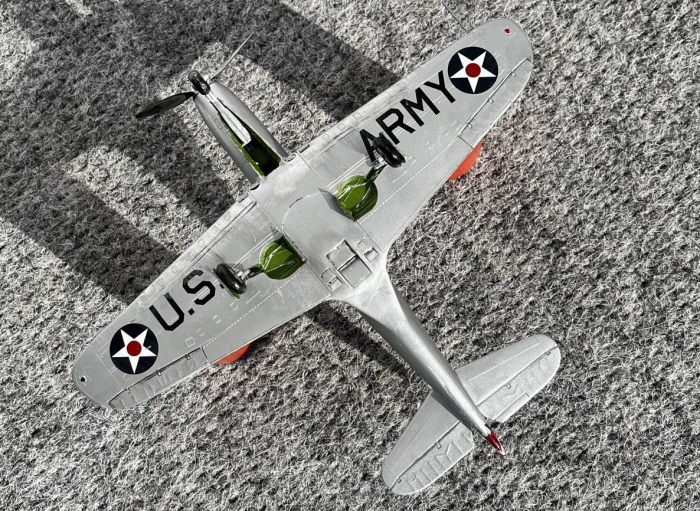 Technology
advances narrowly missed by the 1937 requirement would benefit the next
generation of designs. The P-47 would successfully integrate the turbo in a
single engine fighter. But notice how much larger and heavier this design is,
the largest single engine fighter to be produced. But a great performer due to
an advanced engine producing 2,000 hp. Then there is the legend of the P-51
being fitted with a British engine. Key among advantages of the Rolls-Royce
engine compared to the Allison was its gear driven two-stage supercharger that
performed well at higher altitudes. Also notice the US Navy stayed away from
turbos as all their designs used mechanical supercharging.
Technology
advances narrowly missed by the 1937 requirement would benefit the next
generation of designs. The P-47 would successfully integrate the turbo in a
single engine fighter. But notice how much larger and heavier this design is,
the largest single engine fighter to be produced. But a great performer due to
an advanced engine producing 2,000 hp. Then there is the legend of the P-51
being fitted with a British engine. Key among advantages of the Rolls-Royce
engine compared to the Allison was its gear driven two-stage supercharger that
performed well at higher altitudes. Also notice the US Navy stayed away from
turbos as all their designs used mechanical supercharging.
So, the XP-39 was re-designed and actually achieved the USAAC performance requirements. However, the XP-39 was some 2,000 lbs. lighter than the production fighter fitted with guns, armor, and self-sealing fuel tanks. But, like its stablemate the P-40, it was operational in strength when we were thrust into war. These mid-thirties designs flown by pre-war trained pilots had to hold the line until the vast numbers of advanced aircraft, flown by pilots produced by an amazingly expanded training program, could be fielded. As such they hold an honored place in American history and their sacrifices must never be forgotten.
| THE KIT |
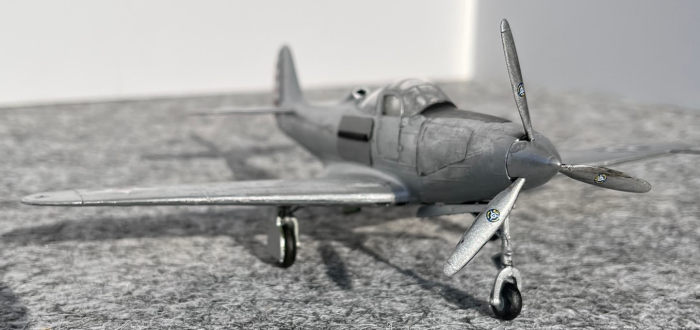 First
produced in 1969 as one of Monogramís heralded quarter scale fighter lineup.
This kit is a 1983 vintage re-issue. The Monogram line which began in the
fifties adapted over the years to a changing hobby clientele. They began with
products that appealed to the average modeler who in the fifties were younger
boys. So those models were less about detail accuracy and more about working
features and gimmicks. Youngsters donít put their toys on a shelf to look at,
they play with them. As those boys grew older and more informed, they began to
take the hobby more seriously. Monogram responded with more accurate and
detailed kits. The operating features such as retractable landing gear went away
in favor of interior details with removable panels to display the builderís
handiwork. This is the point in time this kit was produced. There is a basic
engine molded with a fuselage half with removable covers. There is full gun bay,
and a cockpit door can be posed open to allow one to look around in there. Top
of the line in 69, it has been superseded by more modern offerings. Still, it is
a rather pleasant build and certainly looks the part if one doesnít look too
closely. Decals are for one option, a P-39F of the 488th Fighter
Squadron 59th Fighter Group.
First
produced in 1969 as one of Monogramís heralded quarter scale fighter lineup.
This kit is a 1983 vintage re-issue. The Monogram line which began in the
fifties adapted over the years to a changing hobby clientele. They began with
products that appealed to the average modeler who in the fifties were younger
boys. So those models were less about detail accuracy and more about working
features and gimmicks. Youngsters donít put their toys on a shelf to look at,
they play with them. As those boys grew older and more informed, they began to
take the hobby more seriously. Monogram responded with more accurate and
detailed kits. The operating features such as retractable landing gear went away
in favor of interior details with removable panels to display the builderís
handiwork. This is the point in time this kit was produced. There is a basic
engine molded with a fuselage half with removable covers. There is full gun bay,
and a cockpit door can be posed open to allow one to look around in there. Top
of the line in 69, it has been superseded by more modern offerings. Still, it is
a rather pleasant build and certainly looks the part if one doesnít look too
closely. Decals are for one option, a P-39F of the 488th Fighter
Squadron 59th Fighter Group.
| CONSTRUCTION |
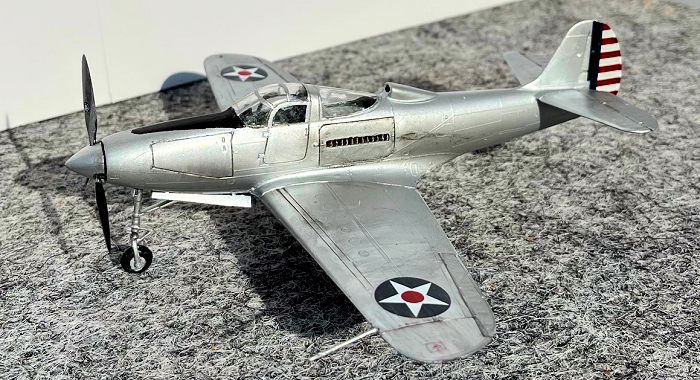 These old kits provide a pleasant
build experience with few hassles, save some gaps here and there to be filled.
One has to decide first whether to build up the armament bay for display or use
that space to add weight. Since I was modeling the unarmed XP-39 I glued a .45
slug to the gun compartment chassis. It fits well and provides the right amount
of weight to keep the model off its butt. I assembled the fuselage and wings per
instructions then began the conversion process to the XP-39. There are some
excellent photos of the aircraft available. Basically, it is filling gun ports
in the nose and wings (including shell ejection chutes) and making a pointed
spinner. Then you sand away all the gun and ammo access panels on the wings.
Next is to re-scribe sanded off panel lines. So, panel line detail is of the
raised variety on this kit. But it works out ok as one would have to examine the
area carefully to see the difference in the raised and scribed lines under
paint. And this model isnít going to any shows. To make the pointed spinner I
cut off some of the cannon barrel molded to a fuselage half that also serves as
a prop shaft. I glued this piece in place in the spinner. Then I dripped thick
super glue down the shaft. I did this repeatedly a little at a time allowing
each application to dry. This built up nicely into the desired cone shape. Then
cut off the protruding barrel and with just a bit of sanding you achieve a nice
point. The only major surgery required was cutting off the centerline bomb rack.
This left a hole that had to be filled. I used Testorís contour putty for this.
Lastly, this kit provides two sets of exhaust stacks, the early 12 port and
later 6 port exhausts. The early 12 port is correct for the XP-39.
These old kits provide a pleasant
build experience with few hassles, save some gaps here and there to be filled.
One has to decide first whether to build up the armament bay for display or use
that space to add weight. Since I was modeling the unarmed XP-39 I glued a .45
slug to the gun compartment chassis. It fits well and provides the right amount
of weight to keep the model off its butt. I assembled the fuselage and wings per
instructions then began the conversion process to the XP-39. There are some
excellent photos of the aircraft available. Basically, it is filling gun ports
in the nose and wings (including shell ejection chutes) and making a pointed
spinner. Then you sand away all the gun and ammo access panels on the wings.
Next is to re-scribe sanded off panel lines. So, panel line detail is of the
raised variety on this kit. But it works out ok as one would have to examine the
area carefully to see the difference in the raised and scribed lines under
paint. And this model isnít going to any shows. To make the pointed spinner I
cut off some of the cannon barrel molded to a fuselage half that also serves as
a prop shaft. I glued this piece in place in the spinner. Then I dripped thick
super glue down the shaft. I did this repeatedly a little at a time allowing
each application to dry. This built up nicely into the desired cone shape. Then
cut off the protruding barrel and with just a bit of sanding you achieve a nice
point. The only major surgery required was cutting off the centerline bomb rack.
This left a hole that had to be filled. I used Testorís contour putty for this.
Lastly, this kit provides two sets of exhaust stacks, the early 12 port and
later 6 port exhausts. The early 12 port is correct for the XP-39.
| COLORS & MARKINGS |
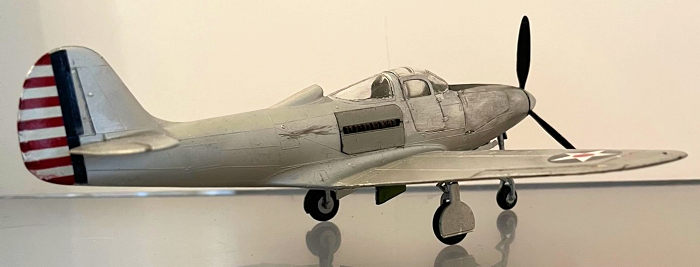 The XP-39 was in unpainted
aluminum. Another departure from the production P-39 was the landing gear also
left unpainted. Though the photos are b&w, they suggest the landing gear doors
were painted green zinc chromate (or that unique Bell interior green). I just
used regular interior green on mine including the cockpit. The airframe was
airbrushed with Model Air metallic Aluminum 71.062. Engine compartment covers
and landing gear were painted Mission Models Duralumin for some contrast. The
spinner was painted Testorís Chrome Silver. The anti-glare panel was masked and
painted Tamiya XF-1 Flat Black as were the tires. The rudder was painted Model
Color White. I used some highly thinned flat black enamel as a wash to pop
engraved hinge and panel lines.
The XP-39 was in unpainted
aluminum. Another departure from the production P-39 was the landing gear also
left unpainted. Though the photos are b&w, they suggest the landing gear doors
were painted green zinc chromate (or that unique Bell interior green). I just
used regular interior green on mine including the cockpit. The airframe was
airbrushed with Model Air metallic Aluminum 71.062. Engine compartment covers
and landing gear were painted Mission Models Duralumin for some contrast. The
spinner was painted Testorís Chrome Silver. The anti-glare panel was masked and
painted Tamiya XF-1 Flat Black as were the tires. The rudder was painted Model
Color White. I used some highly thinned flat black enamel as a wash to pop
engraved hinge and panel lines.
I scrounged some suitable national insignia stars, US ARMY, and Curtiss Electric prop logo decals from some P-40 sheet in the big box of stuff. I found some rudder stripe decals that belonged to some biplane kit I think. It sorta fit with some trimming. The blue had to be augmented by piecing some decal of matching color to make the wider blue stripe on the top half of the rudder. I finished by touching up a few short red stripes with red paint. There are no other markings present on this aircraft.
| CONCLUSIONS |
So building the XP-39 allows one to display a shiny silver Airacobra that you donít see every day. I enjoy building these old Monogram kits. They are like trips down memory lane. The 83 re-pop shows only slight wear of the molds in the form of some molding seams on gear struts and such, easily scraped away. The raised panel line detail is still crisp, and nothing is warped as in todayís Revell re-issue of some these old classics. More modern offerings offer better detail accuracy, for s price. But for an enjoyable problem free build to stick on your shelf I can recommend this old kit. You can still find these on e-bay sometimes at a reasonable price.
| REFERENCES |
Aviation Magazine, March 1940. Wikipedia, the internet, and U-Tube.
9 October 2023
Copyright ModelingMadness.com. All rights reserved. No reproduction in part or in whole without express permission.
Thanks to me for picking this one up when it was on sale.
If you would like your product reviewed fairly and quickly, please contact the editor or see other details in the Note to Contributors.